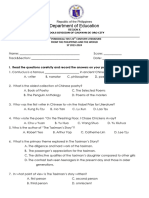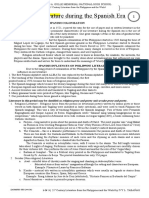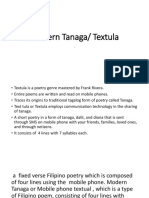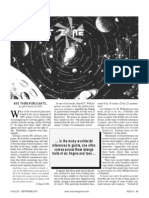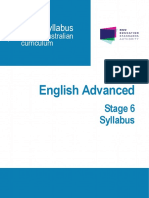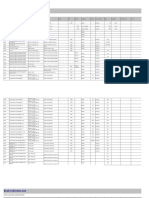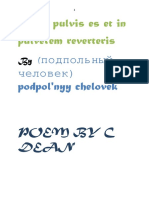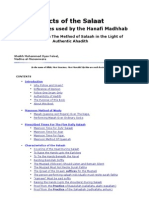50%(2)50% found this document useful (2 votes)
2K viewsA Taste of Philippine Poetry
A Taste of Philippine Poetry
Uploaded by
Krishna Berbano Pama CerbasThe document provides information about different regions, languages, and authors from the Philippines. It discusses the Ilocos region in northern Luzon, including the provinces it contains and their geography. It then examines the poem "Gabu" by Carlos A. Angeles, which depicts the coastline of Ilocos experiencing violent storms and seas. The document next covers the Tagalog-speaking CALABARZON region, and some of its heroes. It also briefly summarizes information about the Visayas region and its sea-based culture. Finally, it introduces several authors from different regions of the Philippines and their works.
Copyright:
© All Rights Reserved
Available Formats
Download as PPTX, PDF, TXT or read online from Scribd
A Taste of Philippine Poetry
A Taste of Philippine Poetry
Uploaded by
Krishna Berbano Pama Cerbas50%(2)50% found this document useful (2 votes)
2K views18 pagesThe document provides information about different regions, languages, and authors from the Philippines. It discusses the Ilocos region in northern Luzon, including the provinces it contains and their geography. It then examines the poem "Gabu" by Carlos A. Angeles, which depicts the coastline of Ilocos experiencing violent storms and seas. The document next covers the Tagalog-speaking CALABARZON region, and some of its heroes. It also briefly summarizes information about the Visayas region and its sea-based culture. Finally, it introduces several authors from different regions of the Philippines and their works.
Copyright
© © All Rights Reserved
Available Formats
PPTX, PDF, TXT or read online from Scribd
Share this document
Did you find this document useful?
Is this content inappropriate?
The document provides information about different regions, languages, and authors from the Philippines. It discusses the Ilocos region in northern Luzon, including the provinces it contains and their geography. It then examines the poem "Gabu" by Carlos A. Angeles, which depicts the coastline of Ilocos experiencing violent storms and seas. The document next covers the Tagalog-speaking CALABARZON region, and some of its heroes. It also briefly summarizes information about the Visayas region and its sea-based culture. Finally, it introduces several authors from different regions of the Philippines and their works.
Copyright:
© All Rights Reserved
Available Formats
Download as PPTX, PDF, TXT or read online from Scribd
Download as pptx, pdf, or txt
50%(2)50% found this document useful (2 votes)
2K views18 pagesA Taste of Philippine Poetry
A Taste of Philippine Poetry
Uploaded by
Krishna Berbano Pama CerbasThe document provides information about different regions, languages, and authors from the Philippines. It discusses the Ilocos region in northern Luzon, including the provinces it contains and their geography. It then examines the poem "Gabu" by Carlos A. Angeles, which depicts the coastline of Ilocos experiencing violent storms and seas. The document next covers the Tagalog-speaking CALABARZON region, and some of its heroes. It also briefly summarizes information about the Visayas region and its sea-based culture. Finally, it introduces several authors from different regions of the Philippines and their works.
Copyright:
© All Rights Reserved
Available Formats
Download as PPTX, PDF, TXT or read online from Scribd
Download as pptx, pdf, or txt
You are on page 1of 18
Identifying Representative
Text From Regions
A TASTE OF PHILIPPINE POETRY
Located in the northwest of luzon the Ilocos region or
region 1 is comprised of four provinces namely: ilocos
norte, ilocos sur, La union, and Pangasinan. It is bordered
to the west by the turbulent south china sea , to the east
by cordillera administrative region, the northeast and
southeast by cagayan valley and the south by Cagayan
valley and the south by central luzon.
Most Of the Inhabitants of the Ilocano homeland are
concentrated along a narrow coastal plain. Because of
Geographical boundaries these people often experience
heavy rains and violent typhoons, especially during
seasons.
GABU
Depicts a coastline in ilocos that is consistently
experiencing the battering restlessness of the sea.
The water that comes back to the store seems
furious and ruthless with its daylong
bashing ,which havocs the wasteland. Being an
archipelagic country, the Phippines knows the
importance of water and the sea
A TASTE OF TAGALOG ESSAY (LUZON)
More popularly Known now as the
CALABARZON Referring to the provinces of
Cavite. Laguna, Batangas, Rizal and Quezon,
Region IV-A is home to Tagalog-speaking people
in the Philippines.
Recognized all over the country for their bravery
and fearlessness in battles, CALABARZON has
participated actively in the country’s fight for
freedom and Democracy.
It is home to many Philippine hero, foremost,
and among them are Rizal of Laguna, Mabini
of Batangas, and Aguinaldo of Cavite.
A TASTE OF CREATIVE NON-FICTION (VISAYAS)
The Island of Visayas is one of the major geographical
divisions in the Philippines, the other two being Luzon
and Mindanao. It is divided into Western, Central and
Eastern Visayas.
The Visayas region is comprised of several islands
circling the Visayan Sea. It’s people therefore, share a
sea-based culture and tradition that may be rooted in a
strong religious foundation.
The dwelling place of many festivals such as the
Ati-Atihan, Di-nagyang, Sinulog, Pintados,
and Maskara, the Visayas may indeed indeed
be considered as one of the cradiles of Philippine
Cvilization
DOCTRINA CHRISTIANA
It was an early book of Roman Catholic
Catechism, written in 1593 by Fray Juan de
Plasencia, and is believed to be one of the earliest
books printed in the Philippines.
FRANCISCO LOPEZ ( ILOCOS REGION)
In fact, the earliest known written Iloko Poems were the
romances he translated from Spanish.
Augustinian Friar who in 1621, published his own Iloko
translation of Doctrina Christiana, the first book to be
printed in Iloko.
LEONA FLORENTINO ( ILOCOS REGION)
Considered by some as the “National Poetess
of the Philippines” wrote Nalipay a
Namnama o naunsyaming Pag-asa (Blasted
Hope)
A Filipino poet in the Spanish and Ilocano
languages. She is considered as the Mother
of Philippine women’s literature” and the
“bridge from oral to literary tradition”
PEDRO BUCANEG (ILOCOS REGION)
He was a Filipino poet who is blind since birth and the
“Father of Ilocano Literature”
He is the acknowledge author of the Ilocano epic Biag ni
Lam.ang.
INES TACCAD CAMMAYO( REGION 2)
First Prize for “ People of Consequences” Don Carlos
Planca Awards for literature, 1970.
2nd Prize for “ Tears Melancoly” Focus literary
contest,1979
2nd Prize for “ On Friends You Pin such Hopes”, Don
Carlos Planca Memorial Awards for literature, 1973
ACTIVITY: GRAPHIC ORGANIZER
Directions: Delve Deeper into the poem Gabu by
Carlos A. Angeles using the graphic organizer. You
may re-read the poem to get the details that would
complete the Organizer.
Title of the Text:
Author of the Text:
QUESTIONS RESPONSE
TOPIC:
What is the text all about?
SITUATIONS:
What is the setting referred to or described in
the text?
CLIENT:
Who is the target group of readers of the text?
How would you describe the group in terms of
skills values, beliefs and attitudes?
PURPOSE:
Why was the text written?
What does it hope to achieve especially among
its client?
PERSONA:
Who is the voice behind the text?
What’s about him or her?
You might also like
- LitCharts Growing OldDocument9 pagesLitCharts Growing OldJasmine DordiNo ratings yet
- John Hospers-An Introduction To Philosophical Analysis - Fourth Edition (1997)Document289 pagesJohn Hospers-An Introduction To Philosophical Analysis - Fourth Edition (1997)Yen-Rong Chang100% (1)
- Canonical AuthorsDocument3 pagesCanonical AuthorsJericho Tan100% (2)
- The Contemporary PeriodDocument42 pagesThe Contemporary PeriodPhoenella Tricia Galo0% (1)
- 21st Century LiteratureDocument86 pages21st Century LiteratureAra Hella Jordas60% (5)
- Esol TestDocument4 pagesEsol TestCarol InaNo ratings yet
- Identifying Representative Texts From The RegionsDocument10 pagesIdentifying Representative Texts From The RegionsAngelica Dyan MendozaNo ratings yet
- Representative TextDocument24 pagesRepresentative Textjeannie tamayaoNo ratings yet
- Philippine Literature in English (1941-1945)Document17 pagesPhilippine Literature in English (1941-1945)June Paul Givero NaagNo ratings yet
- HANDOUT 21st Q1 W2Document25 pagesHANDOUT 21st Q1 W2Char- Mato100% (1)
- Home of The AshfallDocument5 pagesHome of The AshfallMark Andrei Ferreras100% (1)
- 21st Century Literature From The Philippines and The WorldDocument21 pages21st Century Literature From The Philippines and The WorldAngelina De AsisNo ratings yet
- 21st Century Literature - Unit 1 - Lesson 4 - Critical Reading Strategies in LiteratureDocument30 pages21st Century Literature - Unit 1 - Lesson 4 - Critical Reading Strategies in Literaturegrywlf0325No ratings yet
- Edited LAS Grade11 21st Century Lit Week3 Gellie Mae PerezDocument34 pagesEdited LAS Grade11 21st Century Lit Week3 Gellie Mae PerezWendel limbagaNo ratings yet
- 08.2 Ilocano Literature Feature - The Poems of Leona FlorentinoDocument10 pages08.2 Ilocano Literature Feature - The Poems of Leona FlorentinoAdrian YFNo ratings yet
- 21st Century L2-Spanish EraDocument3 pages21st Century L2-Spanish EraMhairo Akira100% (1)
- PaperDocument2 pagesPaperDon Isidro JrNo ratings yet
- The Canonical Authors From The RegionsDocument36 pagesThe Canonical Authors From The RegionsAndrew AlbarracinNo ratings yet
- ANSPadre Faura Witnesses The Execution of Rizal DantonDocument2 pagesANSPadre Faura Witnesses The Execution of Rizal DantonMary Grace Magadia PilarNo ratings yet
- LESSON 2: Philippine Literature During The Spanish PeriodDocument5 pagesLESSON 2: Philippine Literature During The Spanish PeriodZsazsaNo ratings yet
- 21st C. Lit ReportDocument5 pages21st C. Lit ReportMarg50% (2)
- 21st-Century-Lit.-Q2-M1-Close Analysis and Critical InterpretationDocument20 pages21st-Century-Lit.-Q2-M1-Close Analysis and Critical InterpretationJenina Augusta EstanislaoNo ratings yet
- 2ND Quarter Exam 21ST CenturyDocument7 pages2ND Quarter Exam 21ST CenturyMarjory DulanasNo ratings yet
- Lesson 6 Swaddling ClothesDocument34 pagesLesson 6 Swaddling ClothesJemellie TabaganNo ratings yet
- Asian LiteratureDocument20 pagesAsian Literaturegooogoo100% (1)
- Revolutionary LiteratureDocument4 pagesRevolutionary LiteraturePre Amore100% (1)
- Lola Basyang StoryDocument1 pageLola Basyang StoryJenifer Paglinawan0% (1)
- 21 Century Literature From The Philippines and The WorldDocument15 pages21 Century Literature From The Philippines and The WorldDorothy Dela Cruz NitchaNo ratings yet
- 21st Century Literature of The Philippines and The WorldDocument2 pages21st Century Literature of The Philippines and The WorldMarjorie Ventuales Libo-onNo ratings yet
- Senior High School-21 Century Literature Teaching From The Philippines To The WorldDocument14 pagesSenior High School-21 Century Literature Teaching From The Philippines To The WorldMichelle EstavilloNo ratings yet
- Lesson 2Document21 pagesLesson 2Gil Vhal Molato MangantulaoNo ratings yet
- The Love of Magdalena JalandoniDocument2 pagesThe Love of Magdalena JalandonisneakyllamalionNo ratings yet
- Region 4 CalabarzonDocument5 pagesRegion 4 CalabarzonJericko Allen Resus50% (2)
- A Man Falls To His DeathDocument2 pagesA Man Falls To His DeathRalph Abcd100% (1)
- 21st Century Literature Activity Sheet 02 - Spanish LiteratureDocument4 pages21st Century Literature Activity Sheet 02 - Spanish LiteratureYouie ChyrreNo ratings yet
- 07032021-European Literature Afro-Asian Literature Anglo American Literature African, Latin American and Asian LiteratureDocument4 pages07032021-European Literature Afro-Asian Literature Anglo American Literature African, Latin American and Asian LiteratureDomingo Ignacio100% (1)
- Butch DalisayDocument3 pagesButch DalisayMae Mallapre25% (4)
- Philippine Literature During The Pre Colonial PeriodDocument3 pagesPhilippine Literature During The Pre Colonial PeriodAnna Marie Delos Reyes100% (1)
- Philippine Literary PeriodsDocument4 pagesPhilippine Literary PeriodsKer SaturdayNo ratings yet
- 21st Century LiteratureDocument49 pages21st Century Literaturerobe100% (1)
- Literary Genres, Traditions and Forms From Different National Literature and CulturesDocument15 pagesLiterary Genres, Traditions and Forms From Different National Literature and CulturesGlenn D. Torres50% (2)
- Building The NationalDocument6 pagesBuilding The Nationalkhalid alshamsi100% (1)
- 3rd World GeographyDocument2 pages3rd World GeographyLucia JoaquinNo ratings yet
- UNIT 1 LP Grade 11 21st Century LiteratureDocument12 pagesUNIT 1 LP Grade 11 21st Century LiteratureMiss Chrisitne De Lara100% (1)
- Region 10 Legend The Battle at TagoloanDocument17 pagesRegion 10 Legend The Battle at TagoloanAmeurfina MiNo ratings yet
- Objects Shown in The Pictures. Write Your Answer On Your Answer SheetDocument8 pagesObjects Shown in The Pictures. Write Your Answer On Your Answer SheetLoquellano, Paulo R.0% (1)
- Mobile Phone TextulaDocument7 pagesMobile Phone TextulaGilbert Obanil100% (2)
- Literature From The Eastern VisayasDocument9 pagesLiterature From The Eastern VisayasEllaine Bianca CarriedoNo ratings yet
- Canonical Authors and Their WorksDocument29 pagesCanonical Authors and Their Worksalexander macalalad60% (10)
- 21st Century Japanese PeriodDocument34 pages21st Century Japanese PeriodVianca Andyella Bendo67% (3)
- 21ST Century Literature From The Philippines and The WorldDocument2 pages21ST Century Literature From The Philippines and The WorldVanskhings KhingsmicsNo ratings yet
- Activity Sheet: Elements and Contexts of 21 Century Philippine LiteratureDocument9 pagesActivity Sheet: Elements and Contexts of 21 Century Philippine LiteratureErwin CastilloNo ratings yet
- Updated - The Pre-Colonial ERA in Philippine LiteratureDocument13 pagesUpdated - The Pre-Colonial ERA in Philippine LiteratureKris Jan CaunticNo ratings yet
- Famous Writer From Western VisayasDocument6 pagesFamous Writer From Western VisayasKathleen Claire MontefalcoNo ratings yet
- Module 2 The Evolution of Philippine Art CPARDocument8 pagesModule 2 The Evolution of Philippine Art CPARDayrille Althea Liwag YalungNo ratings yet
- Q2 Q4 Module 1 21st Century Literature 1Document28 pagesQ2 Q4 Module 1 21st Century Literature 1Rejie Nel AquinoNo ratings yet
- 21 Century Literature From The Philippines and The World Point of ViewDocument15 pages21 Century Literature From The Philippines and The World Point of ViewLerwin GaringaNo ratings yet
- A Survey of Philippine Literature - Cristobal ZarcoDocument3 pagesA Survey of Philippine Literature - Cristobal ZarcohIgh QuaLIty SVT100% (1)
- Identifying Representative Texts From The RegionsDocument32 pagesIdentifying Representative Texts From The RegionsRegine Mae Aswigue100% (1)
- Representative TextDocument2 pagesRepresentative TextGwyneth Hezekiah PradoNo ratings yet
- 21st Century Lit Lesson 2 ModuleDocument2 pages21st Century Lit Lesson 2 ModuleFahad M. AbdullahNo ratings yet
- 21st Century Literature From The PhilippinesDocument12 pages21st Century Literature From The PhilippinesNimrod BandillaNo ratings yet
- Week 2Document24 pagesWeek 2Myrna Nicolas100% (1)
- An Essay On Man Alexander PopeDocument2 pagesAn Essay On Man Alexander PopeMădălina IoanaNo ratings yet
- GiantsDocument3 pagesGiantsbenra1100% (1)
- Tiu - Return To CommunityDocument1 pageTiu - Return To CommunityJessaNo ratings yet
- Modern Fantasy Short FormDocument2 pagesModern Fantasy Short Formapi-504468143No ratings yet
- Edgar+Allan+Poe Murders+in+the+Rue+MorgueDocument37 pagesEdgar+Allan+Poe Murders+in+the+Rue+MorgueElenaGarzónGarciaNo ratings yet
- As Lesson 7-FinalDocument3 pagesAs Lesson 7-FinalJessa ArgabioNo ratings yet
- English Advanced Stage 6 Syllabus 2017Document87 pagesEnglish Advanced Stage 6 Syllabus 2017Jieshun WangNo ratings yet
- SMA School First Monthly Examination in English 8 Pantok NameDocument1 pageSMA School First Monthly Examination in English 8 Pantok NameJerson Nido100% (1)
- Orlando and IncandescenceDocument19 pagesOrlando and Incandescenceanon_243369186No ratings yet
- English Literary FormsDocument23 pagesEnglish Literary FormsNikhil TripathiNo ratings yet
- The Shadow of KrampusDocument5 pagesThe Shadow of KrampusODRNo ratings yet
- Nitz HistoryLiteraryArtifact 2013Document18 pagesNitz HistoryLiteraryArtifact 2013Akvilė NaudžiūnienėNo ratings yet
- HumanityDocument5 pagesHumanityCharles JohnsonNo ratings yet
- Interpretive Essay Gladwell 1Document3 pagesInterpretive Essay Gladwell 1api-242177059No ratings yet
- Development of English Prose Through AgesDocument60 pagesDevelopment of English Prose Through AgesUme HaleematNo ratings yet
- Mashal - A Triptych Allegory On Sheol in 1 EnochDocument43 pagesMashal - A Triptych Allegory On Sheol in 1 EnochOctavian D. BabanNo ratings yet
- The Grace of GivingDocument5 pagesThe Grace of GivingGrace Church ModestoNo ratings yet
- Book Collection List: Mateo B. Abao Central Elementary SchoolDocument4 pagesBook Collection List: Mateo B. Abao Central Elementary SchoolMary Ann Magallanes CoñadoNo ratings yet
- STD 8 AE English Revision WorksheetDocument11 pagesSTD 8 AE English Revision WorksheetSAYEE KETKARNo ratings yet
- Narrative Style WritingDocument15 pagesNarrative Style WritingJawaria tahirNo ratings yet
- Nam Pulvis Es Et in Pulverem Reverteris-Erotic PoetryDocument21 pagesNam Pulvis Es Et in Pulverem Reverteris-Erotic PoetrygamahucherNo ratings yet
- Søren Kierkegaard - WikipediaDocument404 pagesSøren Kierkegaard - WikipediaAlp Kinski Attphemus IIINo ratings yet
- Aspects of The Salaat - Hanafi MadhabDocument16 pagesAspects of The Salaat - Hanafi MadhabNazar JoNo ratings yet
- Book ReviewDocument2 pagesBook ReviewQQQns KingNo ratings yet
- Dialogues 1. From An Education: FEO 4 - Prof. Marina CantaruttiDocument3 pagesDialogues 1. From An Education: FEO 4 - Prof. Marina Cantaruttilmg_007No ratings yet
- Tristan & IsoldeDocument52 pagesTristan & IsoldeDavid Serrano100% (4)
- Compound WordsDocument4 pagesCompound WordsAdib Jasni KharismaNo ratings yet






















